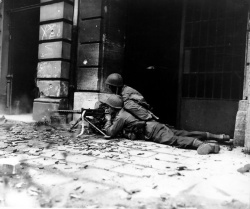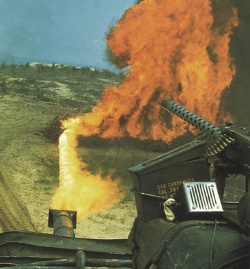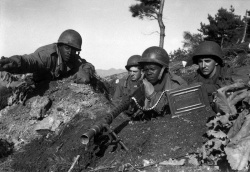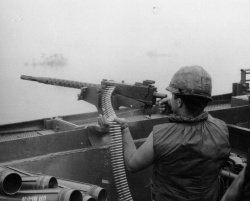M1919 Browning machine gun
| |||||||||||||||||||||||||||||||||||||||||||||||||||||||||
The Browning M1919 is a .30 caliber light machine gun family widely used during the 20th century. It was used as a light infantry, coaxial, mounted, aircraft, and anti-aircraft machine gun by the U.S. and many other countries, especially during World War II, the Korean War, and the Vietnam War. Although it began to be superseded by newer designs in the later half of the century (such as by the M60 machine gun), it remained in use in many NATO countries and elsewhere for much longer.
Many M1919s were rechambered for the new 7.62 × 51 mm NATO round and served into the 1990s, as well as up to the present day in some countries. The United States Navy also converted many to 7.62 mm NATO, and designated them Mk 21 Mod 0; they were commonly used on river craft in the 1960s and 1970s in Vietnam.
Contents |
History
The M1919 was an air-cooled development of the standard U.S. machine gun of World War I, the Browning M1917, as designed by John M. Browning. The weapon originally fired the .30-06 M1 or M2 rifle cartridge from woven cloth or metallic link belts feeding from left to right.
Operation
Loading
Loading was accomplished by opening the top cover, lifting the extractor, inserting the new belt of ammunition into the gun's feed tray, then lowering the extractor over the first round in the belt. As the cover closed, the operator's right thumb made sure the belt feed lever was to the left to ensure the lever fit into the belt feed lever stud cam groove, a machined groove on top of the bolt. After latching the cover, the cocking handle was pulled back palm-up, to avoid thumb dislocation from a 'hot-barrel-cooked-off' round, and released inserting the first round into the barrel's chamber.
Firing
When the rear of the trigger is pivoted upwards by the operator, the front of the trigger tips downwards releasing the sear, and the sear, in turn, releases the firing pin allowing it to strike the primer of the cartridge in the chamber.
Use
As an infantry weapon, it was usually crew operated by 2 soldiers: the gunner, who carried the tripod and ammunition; and the assistant gunner, who carried the weapon, spare parts, and sometimes more ammunition and when in action, fed the ammunition belts into the gun to ensure smooth entry of each round in the belt, decreasing the chance of the weapon jamming.
The original idea was to allow the gun to be more easily packed for transport, and featured a light barrel and bipod when first introduced as the M1919A1. Unfortunately, it quickly became clear that the gun was too heavy to be easily moved, while at the same time too light for sustained fire. This led to the M1919A2, which included a heavier barrel and tripod, and could be continuously fired for longer durations.
The M1919A4 weighed about 31 pounds (14 kg), and usually was mounted on a tripod (for infantry use), or from a fixed mount. It saw wide use in World War II mounted on such vehicles as jeeps, tanks, and ships.
The A5 was an adaptation of the A4 with a forward mounting point to allow it to be mounted in tanks and armored cars. This, along with the M37 and the Browning M2 machine gun, was the most common secondary armament during WWII for the Allies.
Another version of the M1919A4, the M1919A6, was an attempt to make the weapon easier to carry by reducing its weight and to make use of a bipod, but it turned out to be heavier at 32 lbs (15 kg) and was considered "substitute standard". With its bipod and stock, it actually weighed more than the A4 by itself, but less than the A4 with its tripod. It was still used extensively, however, by allied troops during World War II and the Korean War. The main differences were a folding bipod mounted on the front of the gun, a sheet-metal buttstock that was attached to the pistol-grip firing handle, a carrying handle, and a tapered barrel weighing 4 lbs (1.8 kg) instead of 7 lbs (3.2 kg) returning the weapon to an A1-like state.
The Model 1919 was heavily re-worked to become the .30 caliber M2 aircraft machine gun. Key to aircraft use was weight. Unnecessary metal was removed from its components and, with the cooling effect of air rushing past the barrel from the plane's speed, the designers made the barrel thinner and hence lighter. As a result, the M2 weighed 2/3 that of the 1919A4 and the lightened mechanism gave it a higher rate of fire — pertinent to use where the target might be in range and in the line of sight for barely a second.
Other calibers
The same basic weapon was also chambered for the British .303 round, and was used as a basic fighter aircraft gun in fighters such as the Supermarine Spitfire until the widespread introduction of the larger caliber Hispano-Suiza HS.404 cannon, and throughout the war in bombers. Similar versions for a variety of European calibers were delivered by the Belgian gun maker FN (Fabrique Nationale), notably German-standard 7.92 Mauser which was fairly widely used in Eastern Europe.
Production
The M1919 was manufactured during WWII by many different companies in the U.S. including General Motors and Rock Island Arsenal. In the UK production was chiefly by BSA.
Variants and derivatives
M1919 variants
In total there were six variants of the basic M1919 machine gun. The original M1919 featured a relatively heavy barrel, attempting to match the sustained fire capability of contemporary water-cooled machine guns. The M1919A1 featured a lighter barrel and a bipod. The M1919A2 was another lightweight development specifically for mounted cavalry units, utilizing a shorter barrel and special tripod (though it could be fitted to either the M1917 or M2 tripods). This weapon was designed to allow greater mobility to cavalry units over the existing M1917 machine gun. The M1919A2 was used for a short period between World War I and World War II after the cavalry had converted from horses to wheeled and tracked vehicles. An improved version of the M1919A2, the M1919A3, was also developed.
However, by and large the most common variant of the series was the M1919A4, which was used in both a fixed and flexible capacity by infantry and on vehicles. It was also widely exported after the second world war and continues to be used in small numbers around the world. Two variants were developed specifically for vehicular use, the M1919A5, with an extended charging handle, and the M1919A4E1, a subvariant of the M1919A4 refitted with an extended charging handle.
The last variant was an attempt to make the M1919A4 lighter and handier for infantry use. The M1919A6 featured a buttstock and bipod, as well as, a flash hider. While the weapon was supposed to be more useful as a light machine gun, it was still heavy compared to contemporary weapons in the role, and was generally not regarded favorably.
M2 aircraft gun
A specific aircraft version of the Model 1919A4 was manufactured by Browning with a thinner barrel and thinner receiver walls. It was used on pre-WW2 US aircraft but was replaced by the larger .50 caliber M2 machine gun and relegated to training duties. Also a derivative of this weapon was built by Colt as the MG40. This weapon should not to be confused with the Browning Machine Gun, Cal. .50, M2, Aircraft, and its full designation is Browning Machine Gun, Cal. .30, M2, Aircraft. It is sometimes referred to as AN/M2. The AN/ part of the nomenclature stood for "Army-Navy" and was used to describe joint systems until the end of the Second World War.
This weapon soldiered on for a short period during the 1960s as the main weapons for early AC-47 Spooky Gunships in Vietnam, until sufficient Miniguns could be acquired.
Today, like other members of the M1919 pattern, the M2 is popular with civilian enthusiasts, who have in some cases fitted their guns with buttstocks and bipods to allow for use without a tripod or other mount. The modified AN/M2 consisted of a butt stock from a US M1 Garand fastened to the receiver of the Browning machine gun, a rear sight typically from a BAR 1918 and an improvised trigger. These conversions were based on field conversions by soldiers in the Pacific Theatre during the Second World War. A weapon of this type was used by Marine Corporal Tony Stein in the invasion of Iwo Jima, who would posthumously receive the Medal of Honor for his actions during the battle. It had a rate of fire in excess of 1,200 rpm and was nicknamed the "Stinger."
M37 and Mk 21
After the Second World War, two additional variants of the M1919 were adopted by the US military. The Coaxial M37 variant, with the ability to feed from either the left or the right was one. It also featured an extended charging handle similar to those on the M1919A4E1 and A5. A trial variant fitted with special sighting equipment was designated M37F, while a variant with spade grips, the T152, was also developed but not adopted. A variant designed for remote firing via a solenoid trigger for use in the XM1/E1 armament subsystem was designated M37C. A version of the M37, rechambered in 7.62x51 mm NATO is rumored to have been created, but even if it was it most likely would have been quickly supplanted by the M60 and M73 Machine guns. The US Navy, however, did convert a number of M1919A4's to this chambering and designated them Mk 21 Mod 0.
International variants and derivatives
The M1919 pattern has been used in countries all over the world in a variety of forms and under a number of different designations.
- The Browning Mk 1 and Mk 2 were older-style Commonwealth designations for the .303 caliber Browning machine guns used on the vast majority of British aircraft of the Second World War at one point or another. The difference between the Mk 1 and Mk 2 versions is unknown, but the weapon visually is quite similar AN/M2 aircraft gun. The post-war designations for these weapons was L3, and they were used by the United Kingdom, Canada, and Australia to designate the fixed (A1) and flexible (A2) versions of the M1919A4 in .30-06 caliber. L3A3 and L3A4 denoted sear hold-open conversion of previous L3A1s and L3A2s. The A3 is the modified version of the A1, and the A4 is the modified version of the A2. The Canadians later adopted a separate designation for 7.62x51 mm rechambered M1919A4s for fixed (C1) and flexible (C1A1) applications. The C5 and C5A1 were product improvements of the previous C1 and C1A1 respectively.
- FN-Browning mle 1938 was the French designation for the FN-built derivative converted to 7.5 mm MAS ammunition. Manufactured in the late 1930s, and used on fixed mountings of U.S.-built aircraft in French service from 1939 to 1942.
- MG A4 is the Austrian designation for the M1919A4, not to be confused with MG4, a South African licence-built version of the M1919A4 in current use with the South African National Defence Forces (SANDF). The MG4 is manufactured by Lyttleton Engineering, Pretoria. Mg M/52-1 and Mg M/52-11 were Danish designations for the M1919A4 and M1919A5 respectively.
- Ksp m/42 was the Swedish designation for license built M1919 chambered in 6.5 x 55 mm or 8 x 63 mm, and from 1975 circa, mostly fitted with barrels in 7.62 x 51 mm. The Ksp m/42B was a lighter version with bipod and shoulder stock (used in a similar way as the M1919A6), chambered in 6.5 x 55 mm and later in 7.62 x 51 mm.
- The Poles developed a copy of the Browning M1919 chambered for 7.92 x 57mm Mauser, designated Ckm wz.32, similar to the earlier Ckm wz.30.
Commercial variants and derivatives
Colt produced a derivative of the M2 aircraft machine gun, the Colt MG40, which shipped in a variety of calibers including the basic .30-06 Springfield and 7mm Mauser.
Users
- Argentina
- Australia
- Austria
- Cambodia
- Canada
- Denmark
- France
- Israel
- Rhodesia
- South Vietnam
- South Africa
- United Kingdom
- United States
- South Korea
See also
Further reading
- Frank Iannamico, Hard Rain: History of the Browning Machine Guns
- Dolf L. Goldsmith, "The Browning Machine Gun", Vol I & II
External links
- The Light Machine Gun
- M1919A4 Enthusiasts and semi-auto rebuilders
- Gothia Association for Weapon History on the Ksp m/42
- How machine guns work
- History of the Browning Machine Gun at browningmgs.com
| This article is part of a series on the works of John Moses Browning | ||
|---|---|---|
| Semi-automatic pistols | FN M1900 · Colt M1900 · Colt M1902 · FN Model 1903 · M1903 Pocket Hammer · M1903 Pocket Hammerless · M1908 Vest Pocket · FN Model 1910 · M1911 · Colt Woodsman · Baby Browning · Hi-Power | 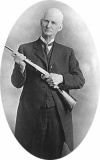 |
| Rifles | Winchester Model 1885 · Winchester Model 1886 · Winchester 1892 · Winchester Model 1894 · Winchester Model 1895 · Remington Model 8 · Remington Model 24 · FN Trombone | |
| Shotguns | Winchester Model 1887 · Winchester Model 1897 · Browning Auto-5/Remington Model 11 · Remington Model 17 · Savage Model 520 · Browning Superposed · Ithaca 37 | |
| Machine guns | Colt-Browning M1895 · Browning M1917 · Browning Automatic Rifle · Browning M1919 · M2 Machine Gun | |
| Cartridges | .25 ACP · .32 ACP · .38 ACP · .380 ACP · .45 ACP · .50 BMG | |

